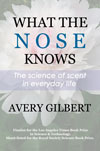
I began my scientific life in animal behavior and was already a post-doctoral fellow when I carried out my first-ever experiment on human smell ability. Even then, it involved animals—specifically, the ability of people to detect odor differences between inbred strains of mice. The mice themselves could smell a difference and preferred to mate with individuals of the other strain. Humans, I discovered, can smell this difference as well, whether the odor source is live mice, mouse urine, or a tiny test tube full of mouse turds.
In What the Nose Knows, I relate how
Deborah Wells and Peter Hepper discovered an even more impressive man-smells-dog story. They had dog owners sniff two identical blankets, of which one had been slept on by their pet and the other by an unfamiliar dog. The owners correctly identified their dog 89% of the time. The strength or pleasantness of the smell was not a factor, nor were non-doggy household odors.This experiment makes the point more effectively than mine, because we are quick to attribute amazing smell ability to dogs while denigrating our own powers.
Now Hepper and Wells—psychologists at Queen’s University Belfast—have upped the ante once again. In a paper soon to be published in Chemical Senses, they repeat the logic of their dog experiment, this time with . . . Western lowland gorillas. Their title says it all:
Individually Identifiable Body Odors Are Produced by the Gorilla and Discriminated by HumansThe odor donors were six gorillas (male and female) living at the Belfast zoo and ranging from four to thirty-six years of age. Each animal was given a clean towel which it kept overnight; most animals slept on it or wrapped it around themselves. Each gorilla had its own sleeping quarters, so mixing of BO was not an issue.
The human sniffers were 100 college students (who else?). They smelled cut-up pieces of gorilla towel from plastic cups. They were given a target sample and a minute later two more samples, one from the same animal, the other from a different animal. Their task to was to determine which of these two scents matched the first.
Under these conditions, every gorilla’s BO was correctly matched by the human panelists. The scent of the silverback male was the easiest to identify, while that of two younger animals was harder to discriminate. To be sure of their finding, Hepper and Wells made the test more difficult. In a second experiment, sniffers had to pick the BO of a target gorilla from samples of all six animals. Under this tougher standard the human panelists were still successful at identifying individual gorillas by scent alone.
Time once again to give the human nose more credit. And, as Hepper and Wells point out, it may be time to take a closer look at the role of olfaction in the social life of the great apes.




3 comments:
Well if some of us can tell apart the sillage of different people, it shouldn't be too much of a challenge to distinguish various gorilla b.o.s...
This great ape tends to sniff at attractive people passing by. I'm sure I'm not the only one. I'm sure it *does* play a role in social life.
Carmencanada:
Here's what puzzles me: we take for granted that people have recognizable scents signatures, yet we regard odor-based social signals in animals as something extraordinary--an extreme ability that we noseless humans lost during evolution.
These studies show we can detect the individual scents of mice, dogs and gorillas. Human and animal nose skills are really on the same continuum, and often on par. Let's hear it for those amazing humans!
I am so with you on this, dear Mr. Gilbert! Another great post. :)
Post a Comment